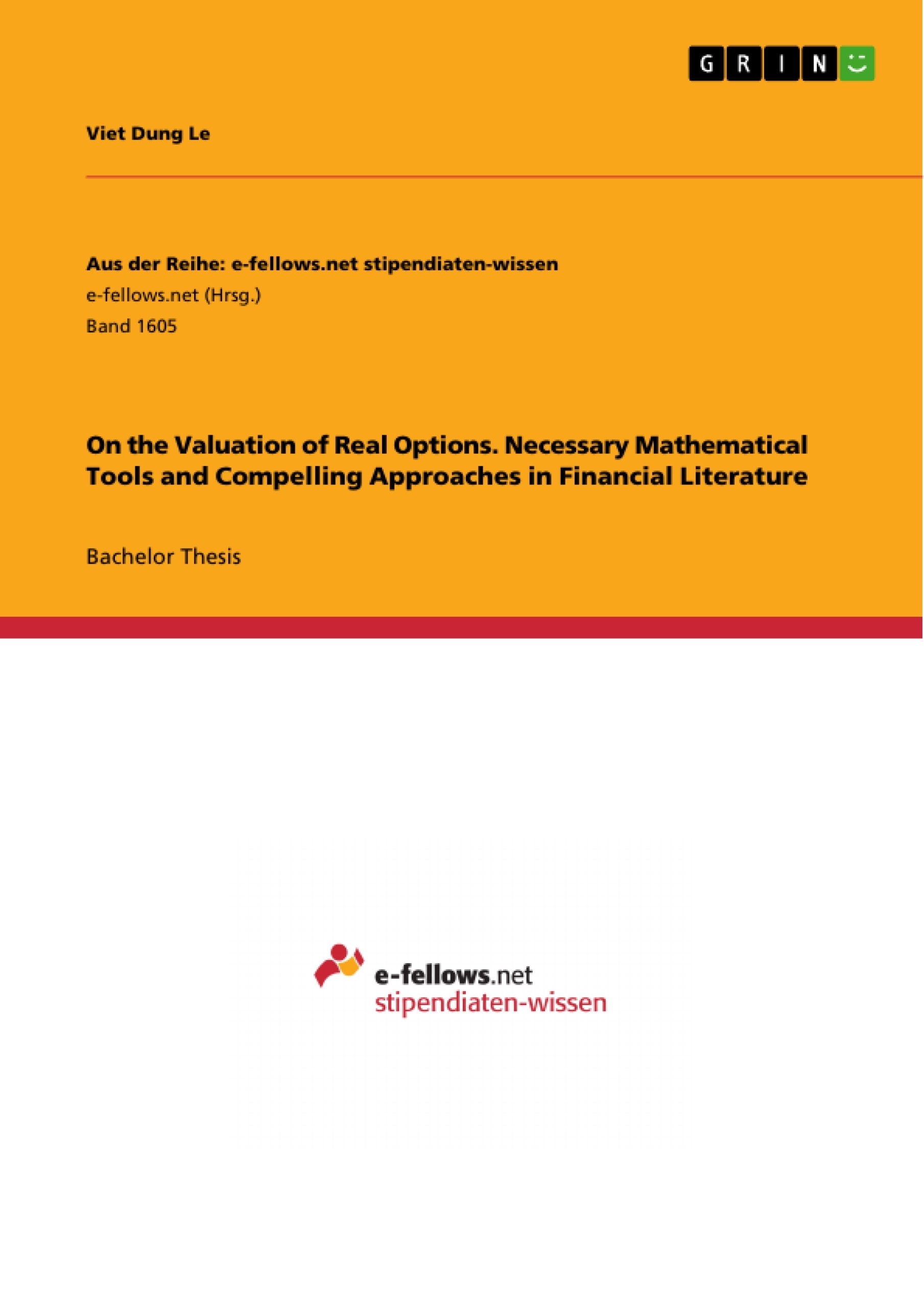
On the Valuation of Real Options. Necessary Mathematical Tools and Compelling Approaches in Financial Literature
Bachelorarbeit, 2015
50 Seiten, Note: 1.0
Leseprobe
Inhaltsverzeichnis (Table of Contents)
- Introduction
- 1 What are Real Options?
- 1.1 Definition
- 1.2 Comparison to traditional Net Present Value method
- 1.3 Types of real options and analogy to financial options
- 2 Real Options Theory
- 2.1 Literature Review
- 2.2 Stochastic Processes
- 2.2.1 The Basic and the Generalized Wiener Process.
- 2.2.2 Itô Process, Geometric Brownian Motion and Itô's Lemma
- 2.2.3 Jump-Diffusion Process.
- 2.2.4 Mean-Reverting Process
- 3 Approaches to Real Option Valuation
- 3.1 Dynamic Programming.
- 3.1.1 Discrete time optimization
- 3.1.2 Optimal Stopping
- 3.1.3 Continuous Time Optimization
- 3.1.4 Value Matching and Smooth Pasting Condition
- 3.2 Contingent Claim Analysis
- 3.2.1 Replicating Portfolio
- 3.2.2 Spanning Assets.
- 3.2.3 Smooth Pasting
- 3.3 Simulation Approach
- 3.4 Comparison of the Approaches.
- 4 Valuing undeveloped petroleum reserves
- 4.1 Valuation of a developed reserve
- 4.2 Valuation of an undeveloped reserve
- 4.3 Numerical examples.
- 4.4 Final Remarks .
- Conclusion
Zielsetzung und Themenschwerpunkte (Objectives and Key Themes)
This thesis explores the concept of real option valuation as a more comprehensive method for evaluating projects under uncertainty, compared to the traditional Net Present Value (NPV) approach. It aims to provide a thorough understanding of real options by explaining the underlying mathematical tools and exploring various valuation approaches presented in financial literature. Additionally, the paper investigates the reasons for the limited adoption of real option analysis in the industry.
- Real option valuation as a method for project evaluation under uncertainty.
- Comparison of real option valuation to the traditional NPV method.
- Mathematical tools and stochastic processes used in real option valuation.
- Different approaches to real option valuation, including dynamic programming, contingent claim analysis, and simulation.
- Reasons for the limited application of real option analysis in practice.
Zusammenfassung der Kapitel (Chapter Summaries)
The introduction presents the motivation for exploring real option valuation as a more comprehensive method for evaluating projects under uncertainty. It highlights the limitations of the traditional NPV method and introduces the concept of real options as a valuable alternative.
Chapter 1 provides a definition of real options and compares them to traditional financial options. It explores the different types of real options and their analogy to financial options, illustrating the flexibility and value they offer in project decision-making.
Chapter 2 delves into the theoretical framework of real option valuation. It reviews relevant literature, introduces key concepts of stochastic processes, and discusses the applications of various stochastic models, including the Wiener process, Geometric Brownian Motion, Jump-Diffusion process, and Mean-Reverting process.
Chapter 3 explores different approaches to real option valuation, including dynamic programming, contingent claim analysis, and simulation. It examines the strengths and weaknesses of each approach and provides insights into their practical applicability.
Chapter 4 presents a case study on valuing undeveloped petroleum reserves, demonstrating the application of real option valuation in a specific industry. It explores the valuation of a developed reserve and an undeveloped reserve, providing numerical examples to illustrate the process.
Schlüsselwörter (Keywords)
Real option valuation, Net Present Value (NPV), project evaluation, uncertainty, stochastic processes, Wiener process, Geometric Brownian Motion, Jump-Diffusion process, Mean-Reverting process, dynamic programming, contingent claim analysis, simulation, petroleum reserves.
Details
- Titel
- On the Valuation of Real Options. Necessary Mathematical Tools and Compelling Approaches in Financial Literature
- Hochschule
- Europa-Universität Viadrina Frankfurt (Oder)
- Note
- 1.0
- Autor
- Viet Dung Le (Autor:in)
- Erscheinungsjahr
- 2015
- Seiten
- 50
- Katalognummer
- V307164
- ISBN (eBook)
- 9783668056527
- ISBN (Buch)
- 9783668056534
- Dateigröße
- 1292 KB
- Sprache
- Englisch
- Schlagworte
- corporate finance realoptions option pricing valuation derivatives NPV Real Options
- Produktsicherheit
- GRIN Publishing GmbH
- Preis (Ebook)
- US$ 20,99
- Preis (Book)
- US$ 29,99
- Arbeit zitieren
- Viet Dung Le (Autor:in), 2015, On the Valuation of Real Options. Necessary Mathematical Tools and Compelling Approaches in Financial Literature, München, Page::Imprint:: GRINVerlagOHG, https://www.diplomarbeiten24.de/document/307164
- Autor werden
- Ihre Optionen
- Vertriebskanäle
- Premium Services
- Autorenprofil
- Textarten und Formate
- Services für Verlage, Hochschulen, Unternehmen

- © GRIN Publishing GmbH.
- Alle Inhalte urheberrechtlich geschützt. Kopieren und verbreiten untersagt.
- info@grin.com
- AGB
- Open Publishing
Der GRIN Verlag hat sich seit 1998 auf die Veröffentlichung akademischer eBooks und Bücher spezialisiert. Der GRIN Verlag steht damit als erstes Unternehmen für User Generated Quality Content. Die Verlagsseiten GRIN.com, Hausarbeiten.de und Diplomarbeiten24 bieten für Hochschullehrer, Absolventen und Studenten die ideale Plattform, wissenschaftliche Texte wie Hausarbeiten, Referate, Bachelorarbeiten, Masterarbeiten, Diplomarbeiten, Dissertationen und wissenschaftliche Aufsätze einem breiten Publikum zu präsentieren.
Kostenfreie Veröffentlichung: Hausarbeit, Bachelorarbeit, Diplomarbeit, Dissertation, Masterarbeit, Interpretation oder Referat jetzt veröffentlichen!
- GRIN Verlag GmbH
-
- Nymphenburger Str. 86
- 80636
- Munich, Deutschland
- +49 89-550559-0
- +49 89-550559-10
- info@grin.com
-









